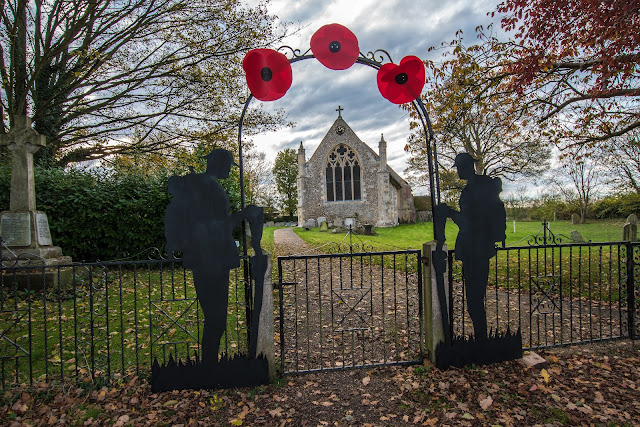Lest we forget - Hadleigh and others
The displays around the district were also a poignant reminder of the suffering and loss of life in the Great War - still remembered 100 years on. They ranged from the simplistic but effective display in Raydon, to the huge 21000+ poppy display in Sudbury.
The beautiful, simple display of Raydon Church.
The amazing cascade in Sudbury. A cascade of more than 21,000 knitted and crocheted poppies covering the local church, many of which were donated from all over the world.
While I was dodging traffic to get my photograph , this rainbow appeared behind the church.
I wonder what he would have made of it all?
This display in the Castle Park, Colchester, features willow sculptures and a floral World War One tank, and incorporates over 11,000 plants. It is the town`s commemoration of the centenary of the end of World War One, as well as remembering the town’s important role during the conflict, when up to 20,000 soldiers were stationed in the town, and 1,263 men from the borough who sadly lost their lives.
And then we had displays (below) in Hadleigh. Some in the Church and other commemorations on railing in the high street.
A couple of images of the display in St Mary`s Church in Hadleigh
The mural on Magdalen Road was painted by Mark Brennan and Jane Olive
Commemoration by the school children of Hadleigh
The Australian and New Zealand Army Corps (ANZAC) was a First World War army corps of the Mediterranean Expeditionary Force. It was formed in Egypt in December 1914, and operated during the Battle of Gallipoli.
The role of women in the World War One was huge, as this excerpt from the BBC History states:
Women and the war
As men left their jobs and went overseas to fight in the war, suffragist and suffragette leaders volunteered their members to take their place. At first, the government met their offer with patronising remarks. But by 1915, as the war forced Britain to recruit more and more soldiers, the women's willingness to volunteer could no longer be ignored. Hundreds of thousands of women were employed in industries key to the war effort, such as munitions factories and weapons manufacturers. Many more women worked as conductors on the buses and trams, as labourers on farms, in hospitals as nurses and in offices as secretaries and assistants.
With the majority of young men enlisted in the army, the role these women played was crucial not only to the war effort but also to the running of the country. Even during the worst of the war, the buses still ran and the mail was delivered.
These two images show local tributes to that effort.
Soldiers at the Hadleigh War Memorial
After the laying of the wreaths
Flypast by two Apache helicopter Gunships




















Comments